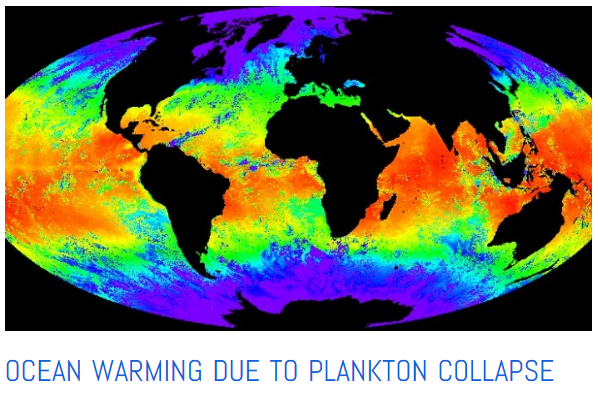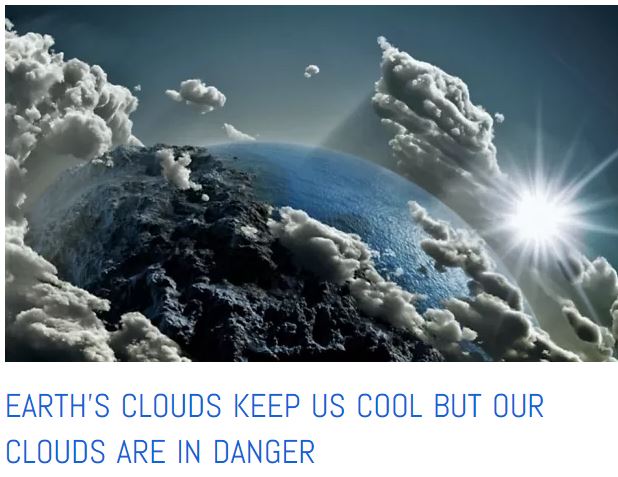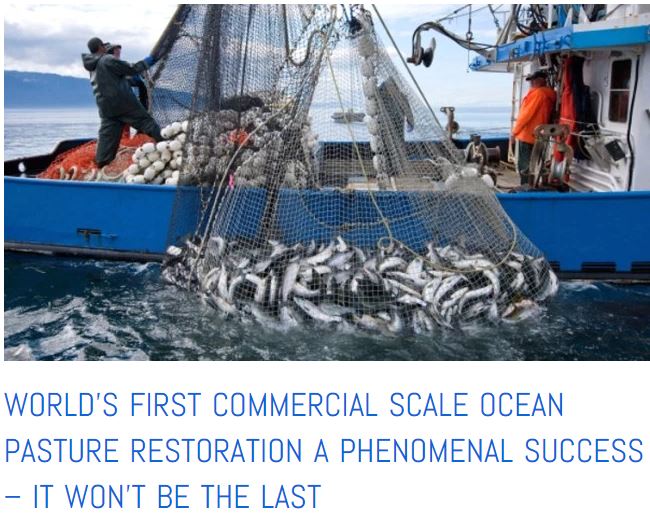
Greatest Uncertainty In Climate Change Models Is Diminishing Cloudiness
The most prodigious contributors of cloud forming aerosols are ocean biogenic processes, aka ocean pastures, presently in a diminished and declining state.
Restoring ocean pastures and their cooling clouds in 10% of the area available would offset the warming from a doubling of greenhouse gas emissions!
Anthropogenic impacts on cloud producing aerosols constitute the largest source of uncertainty in quantifying the radiative forcing of climate, and hinders our ability to determine Earth’s climate sensitivity to greenhouse gas increases.
Climate science groups now call for large scale distant ocean pasture ‘cloud making experiments’ so that the climate models can be made better… An even better idea is to restore ocean pasture cloud production to save the planet!
Climate scientists propose in a new paper published in the widely read open source science journal Earth’s Future that by restoring cloudiness to selected areas of distant oceans a planetary cooling effect sufficient to offset a doubling of greenhouse gas emissions could be achieved with as little as a 10% increase in cloudiness over pristine open ocean pasture regions. Another way to consider this bold statement is that restoration of ocean pastures to former condition of health and abundance would produce sufficient cloudiness to offset ALL of Yesterday’s CO2, as yesterday’s CO2, the trillion tonnes already emitted, is equal to doubling tomorrow’s emissions.

Restoration of ocean pastures and their plankton will replenish natural, biogenic, aka ocean pasture aerosols that make our cooling clouds. – click to read more
The authors note that climate model simulations indicate that regions of extensive marine low clouds account for a large portion of the global aerosol driven global cooling. They explain that while this may seem counter-intuitive, marine clouds in these pristine areas are very susceptible to small changes in aerosols. That fact leads to understanding both the cause and the cure that is inherent to the collapse of natural climate management by the largest of all ecosystems on this blue planet.
The image at the top of this post is of clouds produced by the exhausts of large cargo ships which proves that very tiny changes in aerosols, in that case exhaust aerosols, will produce bright cooling clouds over vast ocean areas.
Safeguard the Climate Restore the Ocean Pastures
The boffins state that even very small changes in aerosol sources in these regions such as increased ocean biological activity or volcanic emissions can lead to significant changes in cloud properties and cloudiness. Which may result in dramatically effective and immediate means to safeguard the climate.

Earth has always been just a bit too close to our Sun for comfort. If it were not for the cooling effect Mother Nature evolved in her ocean ecosystems of our Blue Planet we’d not be in our comfortable “Goldilock’s Zone” – click to read more
They boldly call for the urgent need for controlled experiments in these areas, well away from populated regions, which could yield critical information on how aerosol-cloud interactions in both the real world and in climate change models.
Turning the aerosol source on and off with a predetermined temporal signal will produce temporally varying responses that can be measured and used to evaluate aerosol efficacy and regional cooling potential. In addition, regions of clouds adjacent to perturbed regions with similar characteristics can be monitored to serve as an experimental “control.”

In the Journal Nature portending global warming doom is reported to result from diminishing clouds. – click to read more
Studies referenced in the new paper suggest it may also be possible to enhance and brighten clouds in localized regions to reduce coral bleaching, relieve heat stress on coastal redwood forests, and influence downwind rainfall in drought stricken airsheds. Naturally the most immediate benefit of restoring the health and productivity of ocean pastures will be seen in the return of fish and sea life to historic levels of health and abundance.
While an experiment that might have satisfied the scientists calling for just this sort of work has been performed it was done in 2012 in the very cloudy North Pacific where no hope of observing increased cloudiness was possible. However that experiment was not designed as a cloud aerosol experiment but rather as work to prove practical technology to restore ocean primary productivity and to bring back the fish.
It just worked! The ocean salmon pasture was restored and the fish returned to historic abundance as seen by the largest catch in all of history in near-by Alaska. One of the five species of North Pacific salmon, the Pink Salmon, the most numerous of all was expected to be caught the following year in numbers of between 50-52 million in Alaska. Instead the salmon canneries and freezer warehouses had to stop buying fish from the fishermen once the catch exceeded 226 million fish, 4 times the largest catches on record.
Had there been more room to buy more fish perhaps 500 million fish would have been caught, reports from all the rivers and streams throughout the North Pacific were that everywhere the salmon were unable to fit into those rivers and streams for their spawning season.
All of those salmon were fed by the ocean pasture that had returned to health and abundance and in doing so, powered by photosynthesis, ocean phytoplankton captured and repurposed into new ocean life tens of millions of tonnes of CO2 that would otherwise was destined to become deadly ocean acidification. The carbon capture power of ocean pastures was thus proven to be what it has always been the single greatest controlling mechanism for climate changing CO2 on this blue planet.









